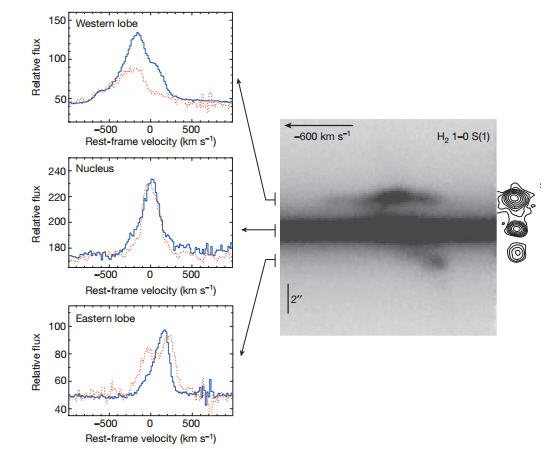Supermassive black holes in the cores of some galaxies drive massive outflows of molecular hydrogen gas. As a result, most of the cold gas is expelled from the galaxies.
Since cold gas is required to form new stars, this directly affects the galaxies' evolution and those outflows are a key ingredient in theoretical models of the evolution of galaxies, but it is a mystery how they are accelerated. A new study provides the first direct evidence that the molecular outflows are accelerated by energetic jets of electrons that are moving at close to the speed of light. Such jets are propelled by the central supermassive black holes.
Using the Very Large Telescope of the European Southern Observatory in Chile to observe the nearby galaxy IC 5063, researchers found that the molecular hydrogen gas is moving at extraordinary speeds – over 600,000 miles per hour – at the locations in the galaxy where its jets are impacting regions of dense gas.

Signs of extreme kinematic disturbance in the western radio lobe of IC 5063.The central panel shows a greyscale representation of our long-slit, near-infrared (K-band) spectrum of IC 5063, covering a wavelength range centred on the H21–0 S(1) line. For comparison, a scaled version of the 1.4-GHz radio map of the source is presented on the right. The velocity profiles derived from spectra extracted from three spatial locations across the galaxy are presented on the left, where the solid blue lines represent the H2 1–0 S(1) l52.128mm feature, and the dotted red lines represent the Brackett-gamma feature. Credit: doi:10.1038/nature13520
Lead author Professor Clive Tadhunter from the University of Sheffield said, "Much of the gas in the outflows is in the form of molecular hydrogen, which is fragile in the sense that it is destroyed at relatively low energies. It is extraordinary that the molecular gas can survive being accelerated by jets of electrons moving at close to the speed of light."
What might that mean for our Milky Way galaxy, which is on a collision course with the neighboring Andromeda galaxy? When we collide, the gas will become concentrated at the center of the system, fueling a supermassive black hole, and potentially leading to the formation of jets that will then eject the remaining gas from the galaxy – just as was already observed in IC 5063.
But we have 5 billion years to worry about that.






Comments